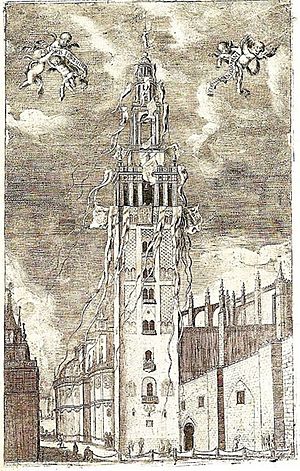Matías de Arteaga y Alfaro facts for kids
Matías de Arteaga y Alfaro (born around 1630, died 1704) was a Spanish artist. He was known for his beautiful paintings and detailed engravings. He lived and worked in the city of Seville, Spain, during the 17th and early 18th centuries.
Contents
Early Life and Artistic Training
Matías de Arteaga was born in Seville around the year 1630. His father, Bartolomé Arteaga, was also an engraver. This likely gave Matías an early start in the world of art.
He learned how to paint from a famous artist named Juan de Valdés Leal. Valdés Leal was a well-known painter in Seville, and he taught Matías many important skills.
Matías de Arteaga's Paintings
Matías de Arteaga mostly painted pictures of the Virgin Mary. His paintings often included detailed buildings and backgrounds. These architectural details made his artworks special.
Some of his important paintings can be found in the church of San Pablo. He created two large altarpieces for this church. An altarpiece is a work of art placed behind the altar in a church.
His Engravings
Besides painting, Matías de Arteaga was also a skilled engraver. Engraving is a method of making prints by carving designs into a surface, usually metal. He created many prints based on the works of other famous artists.
He made engravings of artworks by:
- Juan de Valdés Leal (his teacher)
- Francisco Herrera the Younger
- Alonso Cano, including an engraving of St. Dominick
- Bartolomé Esteban Murillo, such as an engraving of St. Ferdinand

Matías de Arteaga also created engravings for books and special events. For example, he made prints for a book by Fernando de la Torre Farfan. This book described a festival in Seville that honored St. Ferdinand. For this book, Arteaga engraved pictures of the famous Giralda tower in Seville. He also made prints showing the inside and outside of the Seville Cathedral.
Another big project was a series of 58 engravings for a book about St. Juan de la Cruz. St. Juan de la Cruz was an important figure in the Carmelite religious group. Arteaga also engraved a family's coat of arms for a book in 1695.
Signature and Legacy
Matías de Arteaga usually signed his artworks. Sometimes he wrote his full name, and other times he used a shorter version. He passed away in Seville in 1704. His work helped share the art of his time through his detailed engravings and paintings.
See also
 In Spanish: Matías de Arteaga y Alfaro para niños
In Spanish: Matías de Arteaga y Alfaro para niños


